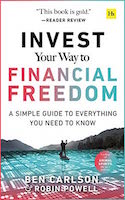I’ve recently been judging my investing track record against hindsight – always a losing proposition – yet fun if you have a masochistic streak
Looking up the ten-year performance of my chosen index trackers, I can easily see what I coulda, shoulda, woulda done instead.
Here’s three decisions that haunt me like some ghost of investing past: clanking its chains and wailing “failure! failure!”
Fail 1: Risk factor investing
I was warned. It’s right there in the strategy’s name: RISK.
The theory of investing in risk factors is you can zhuzh up some extra return by putting money into funds tracking baskets of companies with special properties as defined by clever academics.
These boffins had apparently reverse-engineered the secret sauce of stock picking legends like Ben Graham and Warren Buffett. They then published their recipe for the hoi polloi like me to lap up.
Of course, such factor returns weren’t guaranteed. John Bogle described the concept as a “marketing gimmick” back in 2013. Our own Lars Kroijer warned against them, too.
I dutifully did my research, noted the danger of decades of under-performance, then placed my bets on lesser-correlated, ‘no-promises but it’s a sure thing [wink]’ winners like the Value, Quality, Momentum, and Small factors.
With names like that, how could I fail? (Okay, maybe Small should have set the alarm bells ringing.)
More than a decade later and I feel like I’ve backed the gastropod with a gammy foot in a snail race.
My oh-so-clever smart beta, strategic beta, fundamental indexing, risk premium, factor investing (Christ! How many times do we need to rebrand this thing before it comes good?) funds drag themselves around the track in the wake of my vanilla global tracker year in, year out.
And now I’m trapped:
- The angel on my shoulder says a decade of under-performance goes with the territory. I’ve just gotta hold on.
- The devil says the risk premiums are dead. They were diluted by dumb money like mine the moment they were launched as mass market, fruit-flavoured ETFs.
Forgive me ‘St’ Jack (Bogle). I should have listened to your wisdom:
“Fund performance comes and goes. Costs go on forever.”
Conclusion: Keep reading research that claims my favoured factors are not overvalued, just out of favour. Confirmatory bias for the win my friends!
Fail 2: Buying on the cheap
Buy low, sell high. This heuristic has everything. It’s so beguiling, so contrarian, and as diabolically simple as a poisoned chalice switcheroo.
To action the plan just follow these simple steps:
- Load up on assets after a market fire-sale.
- Wait for mean-reversion to turn the tables in your favour.
- Cash in.
Only loser squares buy high!
This school of thought naturally led me to valuation metrics. Touchstones like the Shiller PE Ratio reputedly reveal when a market is a screaming buy, or else a giant bubble set to burst across the face of humanity.
By that light, the US market has been an inflamed pimple of doom for years.
Meanwhile, the UK and Emerging Markets have been the only major regions that looked remotely cheap for much of my investing life.
“Pah!” thought I. “Success ‘tis as simple as tilting towards these cut-price stocks.”
I might as well have cut my throat. The bargains stayed in the basement.
The FTSE 100 was dominated by big banks.
Me as the Financial Crisis lets rip: “Cripes.”
The FTSE 100 was dominated by big oil.
Me as the world catches fire: “Eeek!”
The FTSE 100 is dominated by big pharma.
Me as the world catches Rona: “Swings and roundabouts.”
As for Brexit…
…let’s not go there.
Conclusion: The FTSE looks like a sin index full of tobacconists, arms companies, booze giants, and miners planning to despoil the world’s beauty spots. That’s gotta be good for profits, right? And the US can’t keep climbing forever while China won’t keep filing the horns off their tech unicorns, surely?
The whole world looks like a basket-case. I best stop trying to be clever.
Fail 3: Rigid adherence to evidence-based investing
If an asset class doesn’t have a 100-year track record then I don’t invest.
Equities, bonds, gold, cash, commodities – I understand what these are for and what they do.
But how do you respond when someone invents something fundamentally new (hello, crypto) that could be a game-changer or a ponzi scheme?
Well, if you’re my co-blogger The Investor you scoop it up like a schoolboy at a rock pool. This guy collects securities the way others collect stamps.
If you’re The Accumulator you sit on the sidelines like a hunter-gatherer who can’t believe this farming lark will ever catch on.
Meanwhile, you torture yourself with crypto-millionaire fables – because even a caveman has to have a hobby.
Perhaps I should have started that fun money portfolio after all. That would help me escape my ideological constraints and silence the second-guessing.
Conclusion: The small probability of a major pay-off is tempting but I haven’t got enough money to chase every pot o’ gold story. Ethereum, meme stocks, NFTs. The opportunities to invest in things I don’t understand are endless and the casualties under-reported – like victims of the Onecoin scam.
Grateful for the investing mistakes I didn’t make
Comparing yourself to humanity’s fat-tail winners is a curse of the modern age, but I have a better idea…
Think about what went right.
I made it to financial independence, early. I’ve got enough to live on for the rest of my days. I can’t compete with my neighbour’s lambo but on the global scale, I hit the jackpot.
I’m happier than I’ve been for… decades. Wow! That realisation just fell out of my fingers as I was typing. It kinda stings my eyes.
I’ve had my share of luck. So it’s okay that I didn’t predict a cat GIF would be worth more than my house.
One happy coincidence for me was stumbling upon passive investing all those years ago.
That simple, replicable, stick-with-it strategy was never going to let me take a bath full of money.
But it’s allowed me to enjoy life’s other riches on tap.
Investing mistakes? I’ve had a few
The mistake this article makes is to view the past through a cock-eyed monocle of failure. Hindsight is 20/20 but it’s blind to chance.
Everyone loses some battles. You just have to win the war.
Take it steady,
The Accumulator




